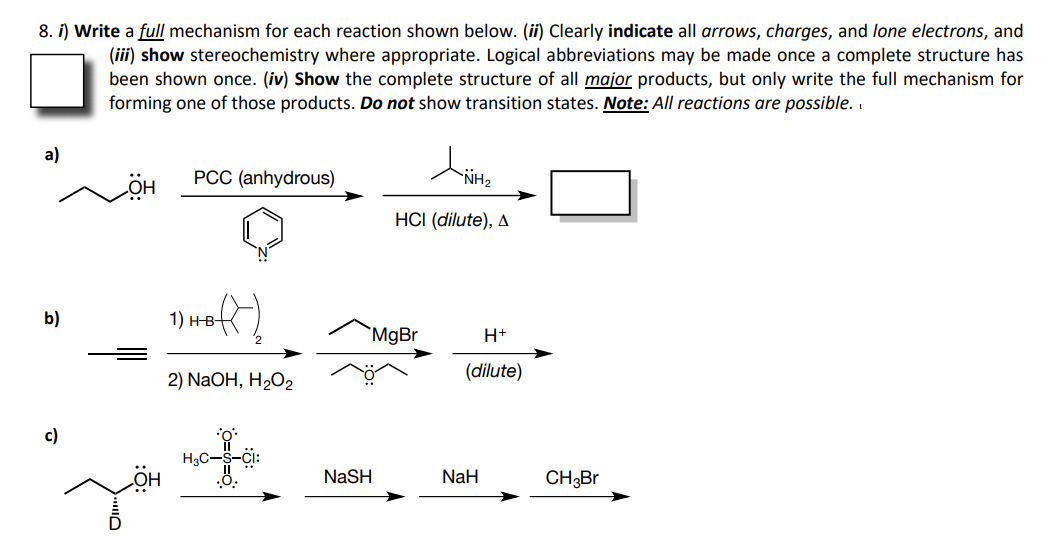8. i) Write a full mechanism for each reaction shown below. (ii) Clearly indicate all arrows, charges, and lone electrons, and (iii) show stereochemistry where appropriate. Logical abbreviations may be made once a complete structure has been shown once. (iv) Show the complete structure of all major products, but only write the full mechanism for forming one of those products. Do not show transition states. Note: All reactions are possible. a) PCC (anhydrous) HÖ HCI (dilute), A b) 1) н-в- `MgBr H+ 2) NaOH, H2O2 (dilute) c) H3C-S-CI NaSH NaH CH3BR HỘ
8. i) Write a full mechanism for each reaction shown below. (ii) Clearly indicate all arrows, charges, and lone electrons, and (iii) show stereochemistry where appropriate. Logical abbreviations may be made once a complete structure has been shown once. (iv) Show the complete structure of all major products, but only write the full mechanism for forming one of those products. Do not show transition states. Note: All reactions are possible. a) PCC (anhydrous) HÖ HCI (dilute), A b) 1) н-в- `MgBr H+ 2) NaOH, H2O2 (dilute) c) H3C-S-CI NaSH NaH CH3BR HỘ
Chemistry
10th Edition
ISBN:9781305957404
Author:Steven S. Zumdahl, Susan A. Zumdahl, Donald J. DeCoste
Publisher:Steven S. Zumdahl, Susan A. Zumdahl, Donald J. DeCoste
Chapter1: Chemical Foundations
Section: Chapter Questions
Problem 1RQ: Define and explain the differences between the following terms. a. law and theory b. theory and...
Related questions
Question
help me please

Transcribed Image Text:8. i) Write a full mechanism for each reaction shown below. (ii) Clearly indicate all arrows, charges, and lone electrons, and
(iii) show stereochemistry where appropriate. Logical abbreviations may be made once a complete structure has
been shown once. (iv) Show the complete structure of all major products, but only write the full mechanism for
forming one of those products. Do not show transition states. Note: All reactions are possible.
a)
PCC (anhydrous)
HÖ
HCI (dilute), A
b)
1) н-в-
`MgBr
H+
2) NaOH, H2O2
(dilute)
c)
H3C-S-CI
NaSH
NaH
CH3BR
HỘ
Expert Solution
This question has been solved!
Explore an expertly crafted, step-by-step solution for a thorough understanding of key concepts.
This is a popular solution!
Trending now
This is a popular solution!
Step by step
Solved in 3 steps with 3 images

Knowledge Booster
Learn more about
Need a deep-dive on the concept behind this application? Look no further. Learn more about this topic, chemistry and related others by exploring similar questions and additional content below.Recommended textbooks for you

Chemistry
Chemistry
ISBN:
9781305957404
Author:
Steven S. Zumdahl, Susan A. Zumdahl, Donald J. DeCoste
Publisher:
Cengage Learning

Chemistry
Chemistry
ISBN:
9781259911156
Author:
Raymond Chang Dr., Jason Overby Professor
Publisher:
McGraw-Hill Education

Principles of Instrumental Analysis
Chemistry
ISBN:
9781305577213
Author:
Douglas A. Skoog, F. James Holler, Stanley R. Crouch
Publisher:
Cengage Learning

Chemistry
Chemistry
ISBN:
9781305957404
Author:
Steven S. Zumdahl, Susan A. Zumdahl, Donald J. DeCoste
Publisher:
Cengage Learning

Chemistry
Chemistry
ISBN:
9781259911156
Author:
Raymond Chang Dr., Jason Overby Professor
Publisher:
McGraw-Hill Education

Principles of Instrumental Analysis
Chemistry
ISBN:
9781305577213
Author:
Douglas A. Skoog, F. James Holler, Stanley R. Crouch
Publisher:
Cengage Learning

Organic Chemistry
Chemistry
ISBN:
9780078021558
Author:
Janice Gorzynski Smith Dr.
Publisher:
McGraw-Hill Education

Chemistry: Principles and Reactions
Chemistry
ISBN:
9781305079373
Author:
William L. Masterton, Cecile N. Hurley
Publisher:
Cengage Learning

Elementary Principles of Chemical Processes, Bind…
Chemistry
ISBN:
9781118431221
Author:
Richard M. Felder, Ronald W. Rousseau, Lisa G. Bullard
Publisher:
WILEY